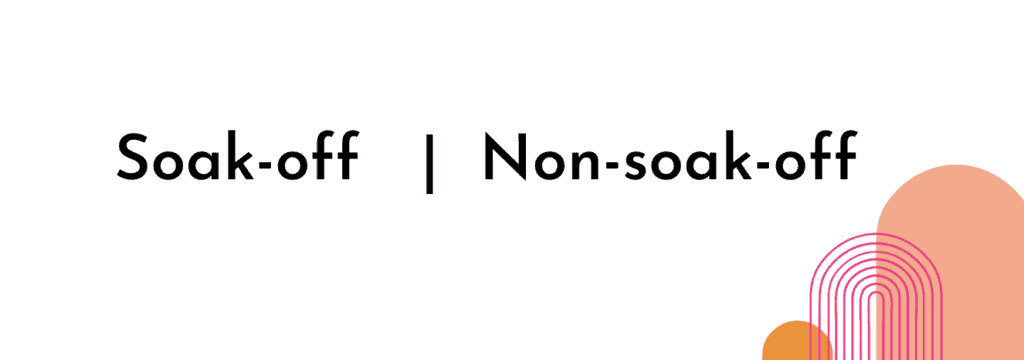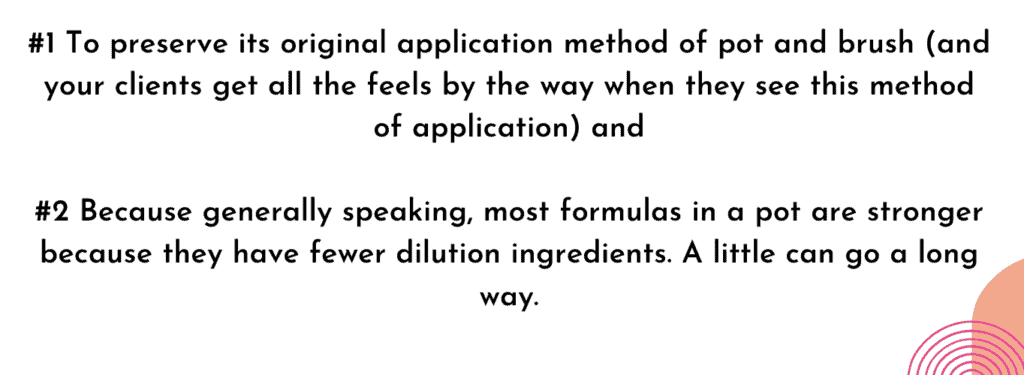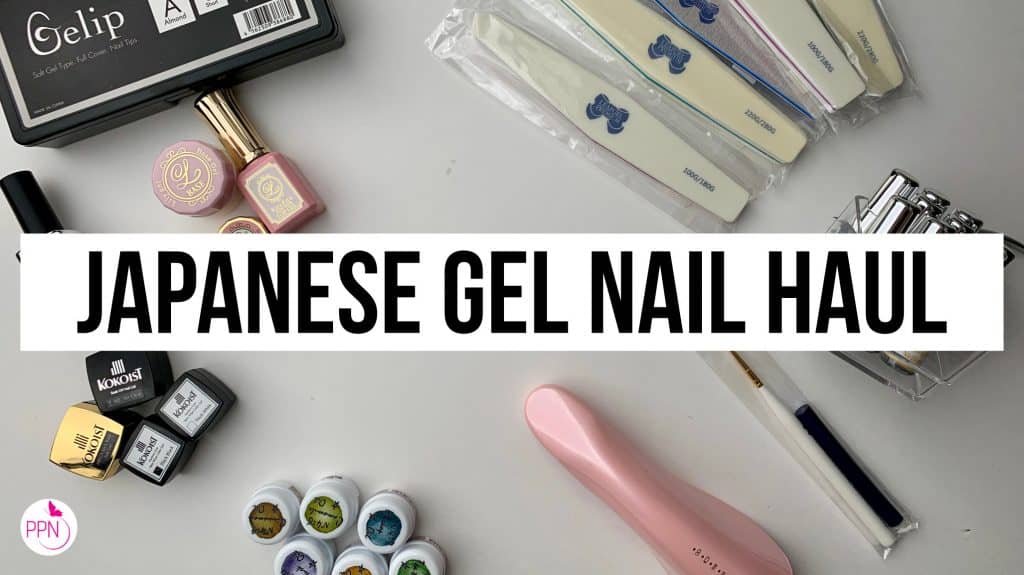Rubber base, gel polish, builder gel, structure gel, soft gel, semi-hard gel, hard gel, soak-off gel, poly gel, premium soft gels… I understand why you’re confused.
I’m so glad that the world of gel nails is exploding, but with it are the gel terms themselves. And the confusion is real, even ‘I’ can’t take it anymore.
It’s essential to keep a baseline of what something is to always return to its origin and understand what we’re talking about.
I hope to provide you with lots of calm during and after this video as we define all the gel terms.
Make sure to save this post; I’m sure you’ll refer yourself and others back to it.
I’m glad you’re here. Let’s get started.
Now, I’m a nail tech and educator with no science background other than some college courses in all the sciences, a little chemistry, biology, physiology, and physics. So my knowledge is not going to be coming from a degree in anything other than just being exclusive to gel nail products since 2015 and having trained with four premium potted soft gel systems, including education with the inventors of UV soak-off gel and 3 of Japan’s top gel nail companies…
Other than that, just sitting here studying the trends and terminology explosion, just like you.
Categories
Let’s start from the very top and understand how gels categorize.
Gels categorize under two categories based on how they can be removed from the natural nail.

Soak-off and non-soak-off (sorry to the English teachers if that’s not a real word, we’ll be using it today, just to keep things super simple).
In other words, once cured, does the gel break down in acetone to be removed.
Soak-off is also known as soft gel.

This is your baseline.

Spoiler Alert… all of the terms we’ll talk about today will fall into either one of these two categories.
Soak-off (soft gel) or Non-soak-off (hard gel).
Now before we get into all the terms.
Soft v. Hard v. Semi-Hard Gels
I want to talk about another instance where gels are described with the words soft and hard.
And in fact, you may even see the term semi-hard.
Once gel is cured, it will have some level of flexibility, and this is another time when you will see the words soft, semi-hard, and hard being used.

Ok, so soft, semi-hard, and hard.
These terms can also describe a gel after it has been cured. …
But remember your baseline. We still need to start with the baseline of how the gel can be removed, as this is important to us nail techs. And also, not only that it helps us determine how we can play with our products because a soft gel over a hard gel enhancement will typically not give you issues.
For example, after a technician has formed an acrylic nail, a hard gel nail, or an acrygel nail putting a soft gel (so a soak-off product) like gel polish color or potted soft gel color, or a soak-off top gel will not cause incompatibility issues that will lead to service breakdowns, as the foundation is solid.
But on the other hand, if you took a soft gel enhancement (so one that does not soak off in acetone), and you put hard products over it, like hard gel or acrylic powder, or even products that do soak off but are hard in the way they cure (i.e., their firmness), there is going to be longevity issues because it is just a matter of time before that bottom foundation, so that soft gel base, bends enough to displace the hard product.
So again, a hard product can hold soft product on top, but typically a soft product cannot hold a hard product on top. Typically. There are some advancements in gel technology, don’t worry about that right now.
Alright, now that we understand the baseline,
I will say it again, soak-off vs. non-soak-off… let’s move on to the terms.
Overlay & Builder
I want to start with the words overlay and builder.
Don’t overthink these.
So, what is an overlay?
An overlay is simply anything overlaying the natural nails. It can be thick, thin, sculpted structured… over a natural nail or plastic tip. It just means to cover any surface with a coating.
Now for those in my MGN Course (learn more here).
You know I use the word overlay to describe my higher-priced service for structuring the nails. So if you’re going to freestyle the word for your use, make sure you help others understand why you’re taking the word out of its original context.
Alright, on to builder gel…
What is builder gel?
A builder gel is just a gel used to build structure on the nail. It can be either soak-off (soft gel) or non-soak-off (hard gel).
It can also come in a bottle or pot, which doesn’t define whether it’s a builder or not.
A builder in a bottle has more dilution ingredients for ease of use, and a builder in a pot is more viscous and can therefore be a little stronger.
Read the product description to find out if it’s soak-off or not… or ask the distributor. If you want to experiment at home, see if it starts breaking down in acetone, but it is much quicker to ask or read. Right?
So then, what is structure gel?
A structure gel is synonymous… yup… a builder gel. So yeah, see previous.
Most of the time, when people say structure gel nowadays, they are referring to a builder in a bottle.
But again, structure in our context of adding body to the nails just means to build…
Now, what is rubber base?
This one makes me giggle… because of the name primarily.
Rubber base gel is a soak-off gel with a little viscosity and definitely some flexibility. It is a soak-off gel, but because it’s a little thicker than just a gel polish base, it can be used with a little apex on the nails and rebalanced. And by that, I simply mean it doesn’t have to be removed completely; you can file it down thin and re-apply.
For many years, I’ve seen the term “rubber base” floating around, particularly on YouTube. And I remember it starting when hard gel technicians began to use soft gel base under hard gel to help the hard gel soak off.
Now, you couldn’t just put any gel polish base down under your hard gel. It had to be a little rubbery for this combo to last. The Gelish Base coat has that characteristic in its base gel of being rubbery (other bases I know to have “rubbery” characteristics are Bio Sculpture Clear Base and Vetro’s Fuji Base)… Rubbery base coat attributes are…remember, a little more viscous and very flexible. And so it was the preferred option.

This then, slowly but surely, started evolving into all the terms you now see floating around used to describe this type of base gel that has a little more viscosity, more flexibility, and is soak-off.
Yup, rubber base, structure gel, builder in a bottle, these all share the characteristics of being a little more viscous, flexible, and soak-off. You see them labeled as whatever sticky trendy word the manufacturer has decided to go with. And they may also make up their own, so be ready for another new word. Just don’t forget your baseline, and you’ll be fine.
So if you’re a loyal subscriber or if you’re new here, we create and host online education on structured manicures all the time… with soak-off gel.
But you’ll hardly ever hear me use any of the trendy terms, and that’s because I’ve always known what the products I use are.
The gel nail products I use are soak-off gel, with ranging flexibility from soft to semi-hard hardness after they’ve cured. I call them potted soft gel. And because they are manufactured with strict quality measures and every in their own private facilities, I refer to them as premium soft gels.
I’ve cared to use nothing else because once I learn what the “new-new” is, I realize it’s the same thing, and what I use is better, a bit of fact and a bit of opinion in that statement. Sorry-not-sorry.
And I started and continue to prefer my gel in a pot for two reasons:

So let’s bring it all together,
The gel baseline is how acetone can break down the product chemically.
So is the gel soak-off or not.
After that,
If it is soak-off, it is categorized as a soft gel. If it is not, it is categorized as a hard gel.
We further learned that all the trendy terms have to do with soft gel.
Hard gel is hard gel. And acry gel, what is commonly termed polygel, I hear is a combination of acrylic powder and gel… but don’t quote me on that.
And we learned that all of the trendy soft gel products with all of their trendy terms are used to perform the very popular structured manicure.
And you also learned that structured gel nails are not new because, basically, since the inception of potted soft gel back in 1988, technicians have been self-leveling their gels to enhance the look and feel of natural nails with this higher viscosity, flexible soft gel, which first originated in a pot to be applied with a brush.
Hey, and if you want to stand apart even further and bring structured gel services to your clients, particularly with gels in a pot, I invite you to check out my free masterclass down below to learn more.
We also have resources and promo codes for our favorite products.
Have a merry start to the week, and I’ll see you in the next one.

Content written by Paola Ponce
Loved this blog? Then I think you’ll love learning more about my journey as a specialized gel nail solopreneur in the nail industry. Click here to get instant access to my free masterclass. These blogs are copyrighted material, and any use of this blog is not permitted without written concern first. Some of these blogs contain affiliate links that give us a small commission when qualifying purchases are made. Thank you for being so supportive, which helps us to continue creating valuable resources and content like this.


![[[ Nail Thoughts X Kokoist ]] Bottled Gel Launch | All COLORS SWATCHED](https://paolaponcenails.com/wp-content/uploads/2020/11/ntswatchesnewthumb-1024x575.jpg)